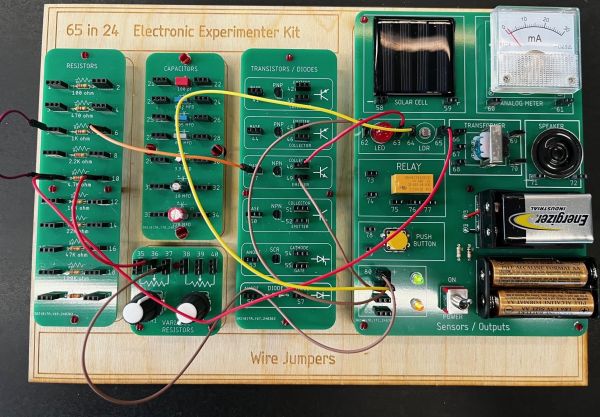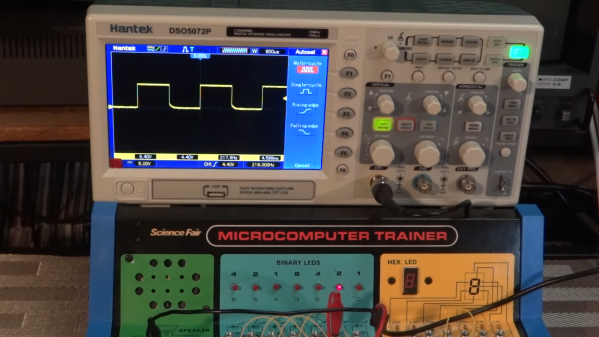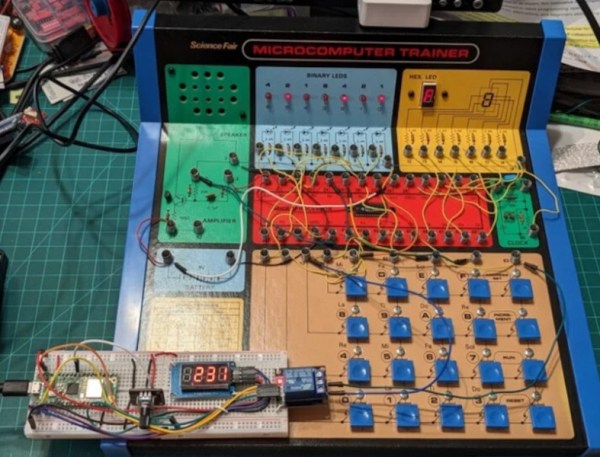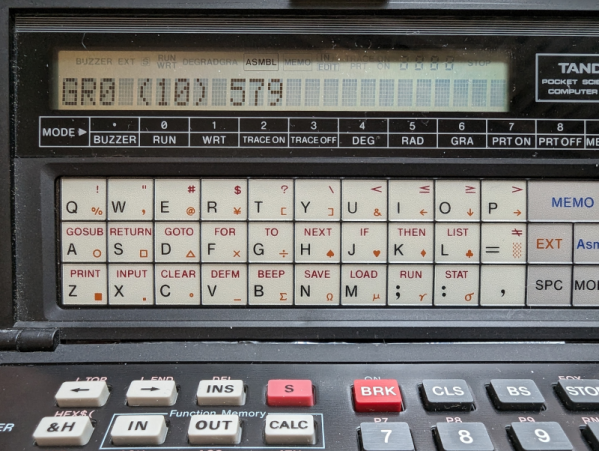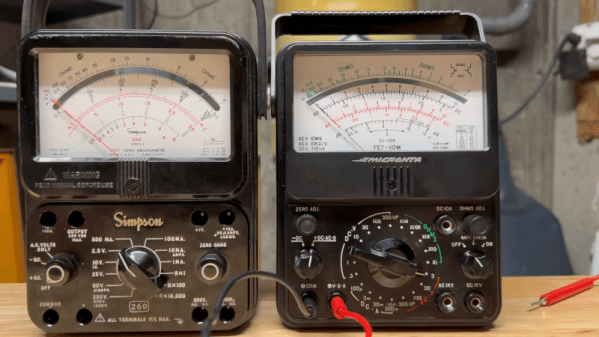It may be hard to believe, but BASIC turned 60 this week. Opinions about the computer language vary, of course, but one thing everyone can agree on is that Professors Kemeny and Kurtz really stretched things with the acronym: “Beginner’s All-Purpose Symbolic Instruction Code” is pretty tortured, after all. BASIC seems to be the one language it’s universally cool to hate, at least in its current incarnations like Visual Basic and VBA. But back in 1964, the idea that you could plunk someone down in front of a terminal, or more likely a teletype, and have them bang out a working “Hello, world!” program with just a few minutes of instruction was pretty revolutionary. Yeah, line numbers and GOTO statements encouraged spaghetti code and engrained bad programming habits, but at least it got people coding. And perhaps most importantly, it served as a “gateway drug” into the culture for a lot of us. Many of us would have chosen other paths in life had it not been for those dopamine hits provided by getting that first BASIC program working. So happy birthday BASIC!
radio shack40 Articles
A 65-in-1 The 2024 Way
If necessity is the mother of invention, nostalgia must be its stepmother, or its aunt at the very least. The desire to recreate long-obsolete devices simply because they existed while we were growing up is a curious trait, but one that’s powerful enough to drive entire categories of hardware hacking — looking at you, retrocomputing buffs.
Hardware nostalgia isn’t all about 6502s and Z80s, though. Even more basic were the electronic toys of the 1970s, such as the Radio Shack 65-in-1 kit that [Tom Thoen] is currently recreating. The 65-in-1 was a breadboarding kit aimed at the budding electrical engineer, with components mounted to colorful cardboard by spring terminals. The included “lab manual” had circuits that could be quickly assembled using a handful of jumper wires. It was an endlessly fascinating toy that undoubtedly launched many careers, present company included.

While the passage of time may not have dulled [Tom]’s memories of his original 65-in-1, technology has marched on, meaning that certain allowances had to be made to create a modern version. He wisely eschews the cardboard for PCBs, one for each of the major component blocks provided in the original, and uses female header connectors in place of the springs. Component choice is tailored for the times; gone are the ferrite rod antenna and variable capacitor of the original, as well as the incandescent lamp, which is replaced by an LED that would have been a significant fraction of the kit’s $21.95 price back in 1976. There’s no BOM yet, so we can’t say for sure if any of the transistors are germanium, but it’s clear that there aren’t any of the old TO-1 cans. But dismay not, originalists, for the meter, relay, CdS photocell, and “solar battery” all made the final cut.
[Tom] has done some beautiful work here, with more to come. We imagine that 3D printing could be used to recreate some details like the original Morse key and speaker grille. We love the laser-engraved backing board, too, as it captures some of the charm of the original’s wooden box. This isn’t the only love for the “Science Fair” brand we’ve seen lately, either; the nostalgia seems to be contagious.
A Deep Dive Into A 1980s Radio Shack Computer Trainer
For those of us who remember Radio Shack as more than just an overpriced cell phone store, a lot of the nostalgia for the retailer boils down to the brands on offer. Remember the Realistic line of hi-fi and stereo gear? How about Archer brand tools and parts? Patrolman scanners, Micronta test instruments, and don’t forget those amazing Optimus speakers — all had a place in our development as electronics nerds.
But perhaps the most formative brand under the Radio Shack umbrella was Science Fair, with a line of kits and projects that were STEM before STEM was a thing. One product that came along a little too late for our development was the Science Fair Microcomputer Trainer, and judging by [Michael Wessel]’s deep dive into the kit, we really missed the boat. The trainer was similar to the earlier “100-in-1”-style breadboarding kits, with components laid out on a colorful cardboard surface and spring terminals connected to their leads, making it easy to build circuits using jumper wires. The star of the show in the microcomputer trainer was a Texas Instruments TMS1100, which was a pretty advanced chip with a 4-bit CPU with its own ROM and RAM as well as a bunch of IO lines. The trainer also sported a peppy little 400-kHz crystal oscillator clock, a bunch of LEDs, a seven-segment display, a speaker, and a rudimentary keyboard.
The first video below is a general introduction to the trainer and a look at some basic (not BASIC) programs. [Michael] also pulls out the oscilloscope to make some rough measurements of the speed of the TMS1100, which turns out to be doing only about 400 instructions per second. That’s not much, but in the second video we see that it was enough for him to nerd-snipe his collaborator [Jason] into coding up an 80-nibble Tower of Hanoi solver. It’s a little awkward to use, as the program runs in spurts between which the user needs to check memory locations to see which disc to move to which peg, but it works.
It looks like people are rediscovering the Microcomputer Trainer all of a sudden. It might be a good time to pick one up.
Continue reading “A Deep Dive Into A 1980s Radio Shack Computer Trainer”
Pi Pico Enhances RadioShack Computer Kit
While most of us now remember Radio Shack as a store that tried to force us to buy batteries and cell phones whenever we went to buy a few transistors and other circuit components, for a time it was an innovative and valuable store for electronics enthusiasts before it began its long demise. Among other electronics and radio parts and kits there were even a few DIY microcomputers, and even though it’s a bit of an antique now a Raspberry Pi Pico is just the thing to modernize this Radio Shack vintage microcomputer kit from the mid 80s.
The microcomputer kit itself is built around the 4-bit Texas Instruments TMS1100, one of the first mass-produced microcontrollers. The kit makes the processor’s functionality more readily available to the user, with a keypad and various switches for programming and a number of status LEDs to monitor its state. The Pi Pico comes into the equation programmed to act as a digital clock with an LED display to drive the antique computer. The Pi then sends a switching pulse through a relay to the microcomputer, which is programmed as a binary counter.
While the microcomputer isn’t going to win any speed or processing power anytime soon, especially with its clock signal coming from a slow relay module, the computer itself is still fulfilling its purpose as an educational tool despite being nearly four decades old. With the slow clock speeds it’s much more intuitive how the computer is stepping through its tasks, and the modern Pi Pico helps it with its tasks quite well. Relays on their own can be a substitute for the entire microcontroller as well, like this computer which has a satisfying mechanical noise when it’s running a program.
Tandy Pocket Computer Assembly Is… Weird
Radio Shack had a long history of buying things overseas, having their name slapped on them, and selling them in the United States. That was the case with the Tandy Pocket Computers, which were in that awkward space between calculators and full-blown computers. Like many computers of those days, if you wanted to do anything interesting, you needed to turn to assembly language. But as [Old Vintage Computing Research] recalls, the assembly for these little devices was very strange, even for an assembly language. He found out that there is a reason it is so strange and shares it in a deep dive into the device’s machine code history.
The story starts with the Japanese government. In 1969, the ministry in charge of such things decided that it wouldn’t be fair for people who knew a particular computer to have an advantage when taking the Information Technology Engineer exam. So, logically, they made up a fictitious instruction set and architecture for the test. Since no one used it, no one would have an unfair advantage.
However, eventually, Japanese manufacturers started making computers that used the architecture. The architecture was COMP-X, and the assembler was CAP-X. The post covers the history of machines either using the architecture or emulating it going back to the 1970s. It eventually winds up at the Sharp and Casio pocket computers that would wear Radio Shack livery in much of the world, especially the United States.
In Praise Of Old Meters
We are spoiled with multimeters today. Even the cheapest meter you will get these days is almost surely digital with a tremendous input impedance. But a few decades ago, meters were almost always analog affairs. To make a precise measurement, you needed a mirror under the meter to ensure you read the needle correctly. Moreover, a common meter wouldn’t have that high of an input impedance. If you spent more, you could get a VTVM and, later, one that used FETs to provide high input impedance. [Peter AA2VG] just picked up a vintage Micronta FET volt-ohm meter to join some of the other new and old meters in his shack. You can check it out in the video below.
[Peter] already has a Simpson and a more modern Fluke meter. The Simpson, however, doesn’t have a tube or FET amplifier. The Fluke is nice, but there is something about the needle on an analog meter. If you aren’t old enough to remember, the Micronta brand was a Radio Shack label.
Will RadioShack Return?
We suspect that if you want to write a blockbuster movie or novel, the wrong approach is to go to a studio or publisher and say, “I have this totally new idea that is like nothing you’ve ever seen before…” Even Star Trek was pitched to the network as “Wagon Train to the stars.” People with big money tend to want to bet on things that have succeeded before, which is why so many movies are either remakes or Star Trek XXII: The Search for 4 PM Dinner Specials. Maybe that’s what the El Salvador-based Unicomer Group had in mind when they bought one of our favorite brands, RadioShack. They are reportedly planning a major comeback for the beleaguered brand both online and in the physical world.
In all fairness, the Shack may be better in our memories than in our realities. It was handy to stop off and pick up a coax connector, even if it cost three times the going rate for one. There was a time when RadioShack offered reasonable parts for projects, and it seems like near the end, they tried to hit that target again, but for many years, you could not find the typical parts for a modern project there anyway. However, Unicomer isn’t just a random group of investors.


